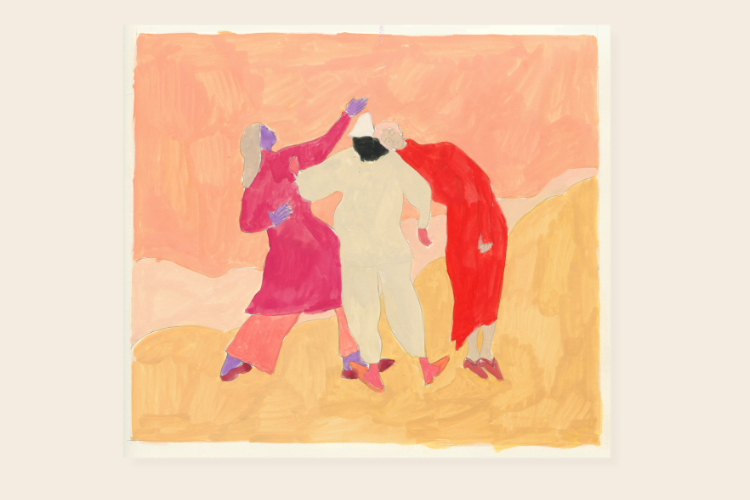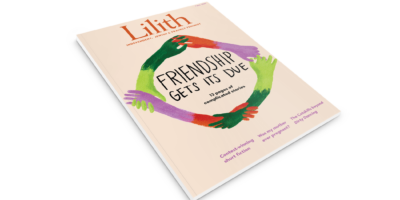
ART: DROR COHEN
What Can Polyamory Teach Us About Judaism?
Three glasses into our aunt’s wedding, my cousin Jules informs my grandmother that he has no intention of getting married to his partner of ten years. For them, he explains, the institution of marriage is in opposition to their identity as a queer polyamorous couple.
I, then blessedly single, am her next most likely candidate.
“Please get married before I die, because Jules won’t.”
Guilt and unsolicited advice. A Jewish grandmother’s greatest weapons.
My grandmother squeezes my arm with one hand and wipes some schmutz off my forehead with the other. I smile at her. As a lump forms in my throat, I turn away. I watch a herd of Jewish relatives dance the hora and hoist my aunt and her new husband into the air towards the ancient redwoods towering above us.
I’ve always known that I wanted to have a Jewish wedding, but my identity as a queer polyamorous person has felt in contradiction to that desire. Do I have a traditional ceremony that excludes my romantic and sexual identity? Or do I sacrifice my desire for a Jewish ceremony? A Jewish wedding would honor the love I feel for my wife, but not the other romantic and sexual connections outside of our primary relationship.
Polyamory, meaning many loves, involves engaging in sexual or romantic relationships with more than one person at a time. People who are polyamorous can be of any sexual orientation and are committed to transparency about each other’s relationships. Some polyamorous people have hierarchies within their partnerships and some do not.
Jews have been practicing polyamory since we have existed, but these days the practice of having multiple romantic and sexual relationships concurrently is pretty taboo among many contemporary Jews. Many rabbis point to kiddushin—the betrothal ceremony before a wedding—as the only ethical model of a relationship, a stance reflected by thinkers in both the Reform and Conservative movements.
How do we validate people whose identities and ways of living, according to many, go against over two thousand years of religious tradition? What happens when there are no existing rituals that fully acknowledge the complexity of these identities?
Rabbi Nikki DeBlosi, Ph.D., is a queer polyamorous rabbi who has spent her career examining these questions of identity and inclusion. “I initially wanted to be a priest,” says DeBlosi, who was raised in
a Catholic household. “That was not an option for women. There are things about Christianity that didn’t match with me, like my feminism, my being queer, and my tendency to ask a lot of questions.”
After falling in love with a Jewish woman, Rabbi DeBlosi converted. Her decision to become a rabbi arose when she was in a Ph.D. program at New York University. After a string of student suicides, DeBlosi was required to read her students from a piece of paper, “If you feel sad about it, you can go to this forum on Thursday,” she recalls. “I care about them as whole people. So I googled, ‘the requirements to become a Reform rabbi.’”
Rabbi DeBlosi has served on the rabbinic staff at the Bronfman Center for Jewish Student Life at New York University and taught about the intersections between contemporary sexuality and traditional Jewish teaching. Her experience as a convert and polyamorous queer Jew prompted her interest in creating rituals to support non-traditional Jewish identities.
Many other leaders of the modern branches of Judaism are right there with her—at least when it comes to queer, trans and nonbinary Jews. Since 2013, many branches of Judaism have come out in support of gay marriage.
Polyamory is more complicated. According to the governing body of Reform rabbis in North America, and The Rabbinical Assembly, the governing body of Conservative rabbis, there is no official rabbinic response on the topic of polyamory. Polyamorous Jews point to biblical patriarchs having multiple wives and concubines as evidence that polyamorous relationships can be sacred in Judaism. Hevrutah, a relationship founded upon studying the Jewish texts, is another potential example of a bond outside of marriage with profound yet ambiguous emotional depth. DeBlosi quotes Shimon ben Azzai, who exclaims, “What can I do? My soul thirsts for Torah” when his hevrutah partner dies. “We haven’t invented anything about sexuality and sex,” she says.
Despite its presence in mainstream culture, polyamory within the Reform Jewish community remains contentious even in progressive spaces. In an article in the Jewish Telegraphic Agency in 2013, Rabbi Elliot Dorff, rector of American Jewish University in Los Angeles, pauses when it comes to polyamory. “First of all, the depth of the relationship is much greater if it’s monogamous,” Dorff said. “The chances that both partners are going to be able to fulfill all the obligations of a serious intimate relationship are much greater in a monogamous relationship.”
Rabbi Sharon Kleinbaum, senior rabbi at New York’s gay synagogue, Congregation Beit Simchat Torah, has said she tries to avoid being judgemental as a rabbi. Polyamory, she says, is “a choice that does not preclude a Jewishly observant, socially conscious life.”
A non-judgemental attitude isn’t enough for those who are polyamorous and want acceptance. “I think some of the Reform movement’s drawbacks have been focusing on this idea of ‘Love is love.’ Everyone’s the same and so we’ll let you in,” says DeBlosi. “That’s great if you’re monogamous and have 2.5 kids and a white picket fence’.” DeBlosi admits that she herself has two kids and an actual white picket fence outside of her house as we speak. Still, she says we must acknowledge identities outside of what we consider “normal.”
An informal survey—she once took of 65 polyamorous Jews and one anonymous spiritual leader—informed DeBlosi’s current thinking on the subject: “We have identities that have no narratives, and that is exhausting,” she says. “Taking the brave steps to practice polyamory is exhausting. We need and deserve spiritual homes.”
Can polyamorous homes exist within the Jewish tradition? Or should polyamorous Jews reject an emphasis on traditional rituals?
“A ritual is an embodied practice that has a history,” Rabbi DeBlosi emphasizes, “There’s a sense of belonging.” Rituals, particularly weddings, are some of the most profound ways that we can honor love and new connections to one another, but their context is as complicated as society itself. “The state kind of defines for us what a marriage is supposed to look like, right? And so when gay marriage was illegal, it was risky for a rabbi to perform a ceremony that looks like a marriage.”
Still, there are rabbis who are eager to adapt rituals in response to cultural shifts. Dan Fink, a rabbi at Congregation Ahavath Beth Israel in Boise, Idaho, told Lilith that the idea of officiating same-sex marriage seemed farfetched a decade ago, and is now a regular practice. But officiating for a polyamorous couple presents complications. “Would I officiate for a polyamorous trio? I’m sure I would—or will, when asked—find a way to sanctify and celebrate their partnership(s) in a Jewish context. Do I know what that ceremony would entail? I don’t,” Fink said.
When polyamorous Jews come to Rabbi DeBlosi to create a ritual, she sits down with them and asks them about their ‘holiness timeline’; “Tell me three moments that let you know this relationship was special.” She gives them lists from the Talmud. “Here’s some responsibilities of husbands to wives and wives to husbands. Are these things on your lists? Do you split them evenly?” These are conversations that poly people have all the time,” says DeBlosi.
Monogamous Jews can learn from the principles of polyamory and apply them to their own relationships, DeBlosi notes: “Polyamory encourages people to discuss openly what their needs are and ask, how can we support one another?”
For polyamorous Jews, Jewish ritual doesn’t need to be a point of contention, but can be a way to honor identity and celebrate community. “Polyamory has actually made me more Jewish,” notes a polyamorous psychotherapist who regularly hosts Shabbat with her partners. “My main way of connecting to Judaism is through ritual. It’s part of my life and important that partners join me in that.”
Polyamory invites us to experience love as a source that is not finite, but abundant. By honoring and adapting our rituals, we allow ourselves the freedom to experience the newfound depths of love and relish the interconnectedness of our community.
For poly Jews, DeBlosi says, risks are “not only rejection or judgment from the Jewish community itself, but also legal and practical risks—like being fired from one’s job, or losing custody of one’s children.”
My girlfriend and I, while queer, represent a nuclear family structure that polyamory disrupts. Inviting my girlfriend to a family Seder goes without question, but the idea of bringing multiple partners was laughable. After talking with Rabbi DeBlosi I wonder, did this feeling stem more from a desire to create security within my primary relationship or from a fear of judgment from family members? Now, the decision whether or not to merge my romantic orientation and religious identity no longer feels threatening but exciting.
Inclusion is not an abstract thought experiment but a conscious decision present at our tables. They deserve to show up as themselves.
Hannah Meyer is a writer and educator based in New York.


